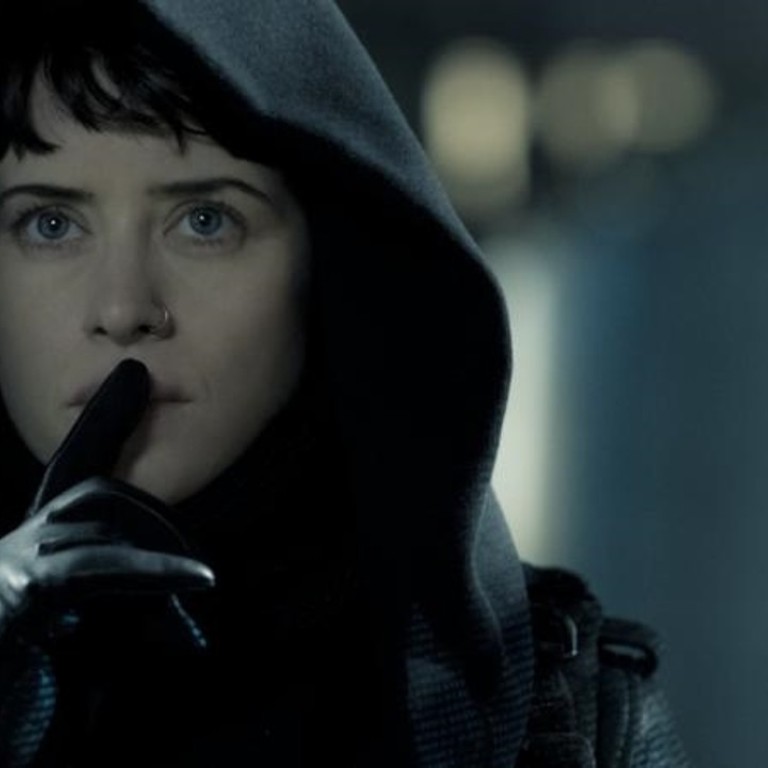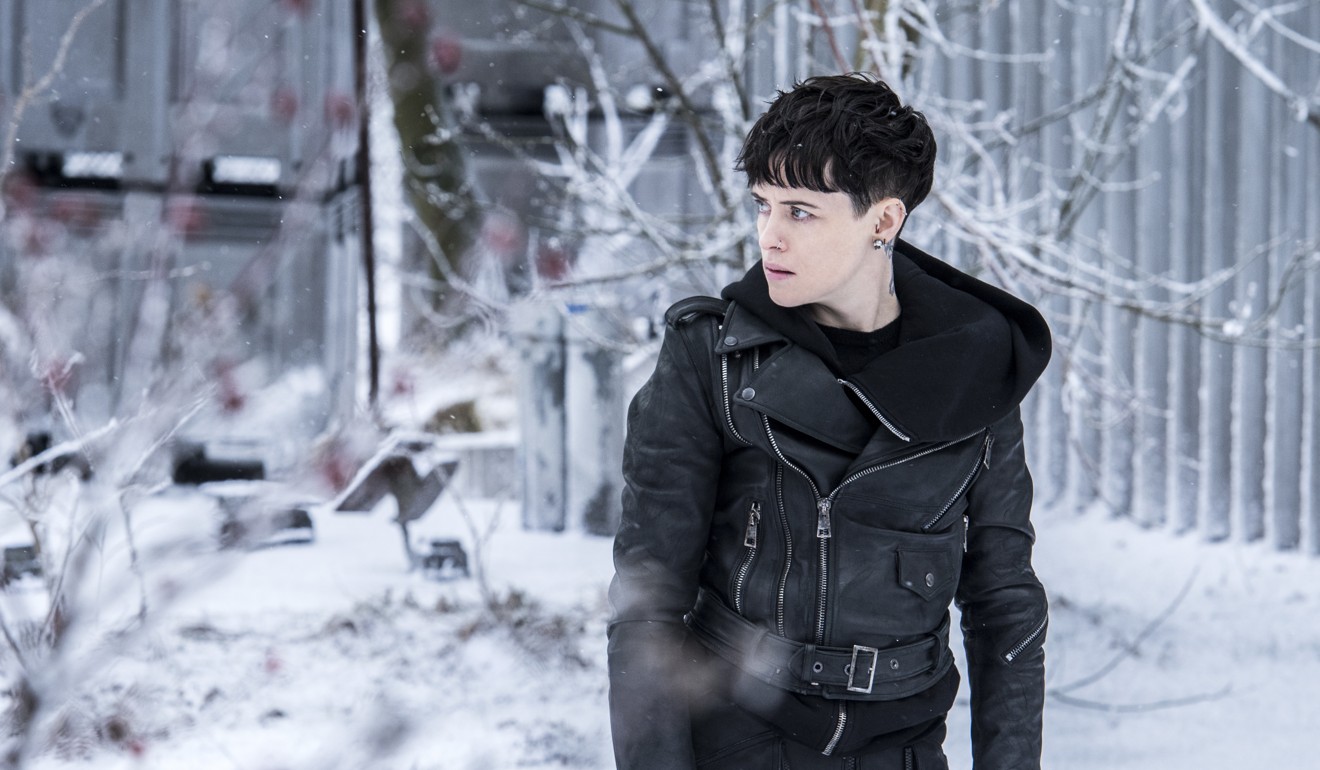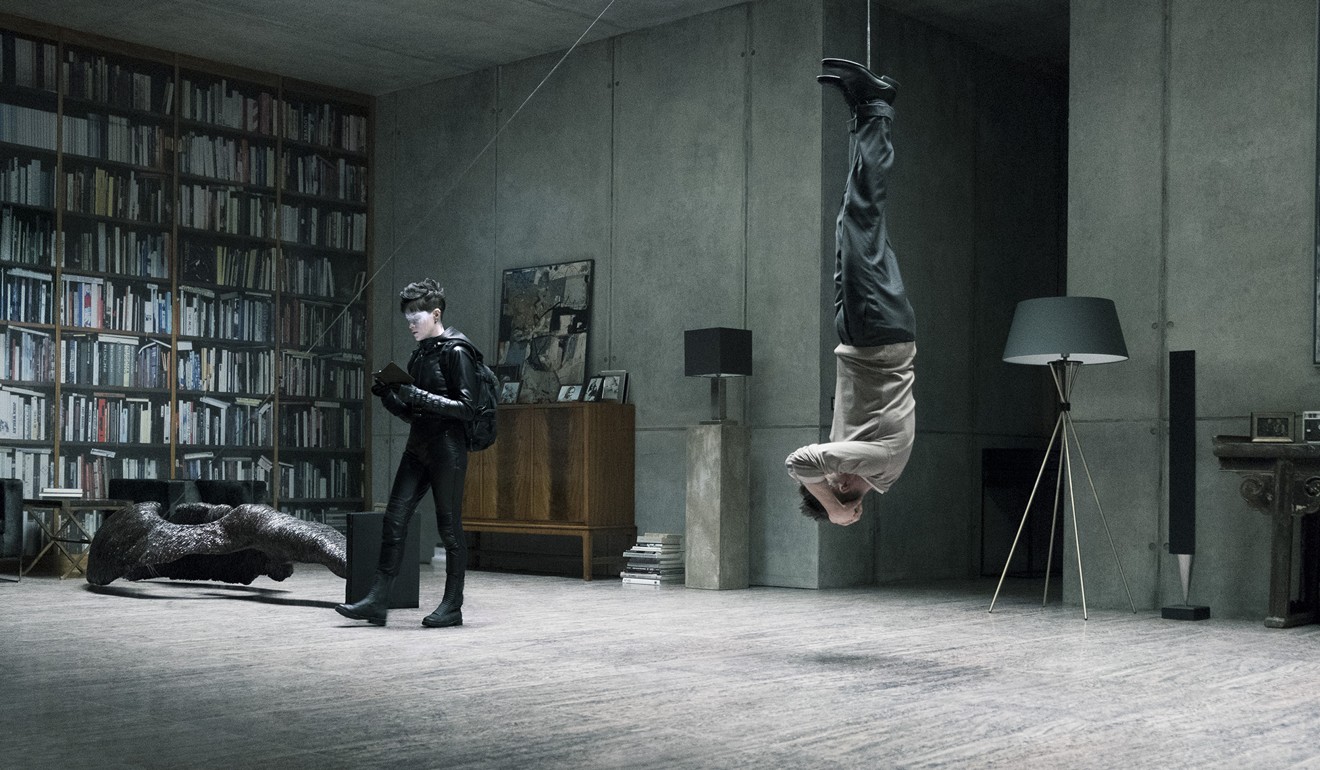
The Crown’s Claire Foy is Lisbeth Salander, but new ‘Girl’ film spins a dull web
- While Stieg Larsson’s post-punk heroine returns in The Girl in the Spider’s Web, her intellect and ingenuity are rarely on display
- Film’s story line is too much like a generic international thriller and, Foy apart, cast replacements are a downgrade on originals
Lisbeth Salander now has a pet – a lizard, to be precise. Lisbeth, lizard: I suppose a salamander also would have been apropos. But the choice feels especially fitting for this most reptilian of 21st-century pop-punk heroines, who sports a massive black tattoo of a dragon on her back.
We get a glimpse of Lisbeth’s brutal origins in The Girl in the Spider’s Web, a disappointingly bland return for everyone’s favourite Scandinavian pansexual goth-vigilante cyber-sleuth.
Stieg Larsson’s legacy honoured in the tattooed girl’s latest outing
Three years in movie time and seven years in real time have passed since the superior chills of David Fincher’s The Girl With the Dragon Tattoo (2011), and quite a lot has changed in the interim. The source material for the follow-up is not Stieg Larsson’s best-selling Millennium trilogy but rather a 2015 novel by David Lagercrantz, written and published years after Larsson’s death.
Lisbeth, played in 2011 by Rooney Mara and in three earlier Swedish-language adaptations by Noomi Rapace, has been bequeathed the flinty gaze and brittle line delivery of Claire Foy. Sverrir Gudnason has the unenviable task of following Daniel Craig as Lisbeth’s journalist sidekick, Mikael Blomkvist.

Perhaps most significantly, the director is not Fincher but Fede Alvarez, whose résumé includes a remake of The Evil Dead (2013) and a scary home-invasion thriller called Don’t Breathe (2016).
One could run down the entire list of cast and crew replacements; suffice to say that Foy is one of the few additions who does not feel like a major downgrade. This will not surprise the many admirers of this British-born, temporarily Swedish-accented star, who is still best known for playing Queen Elizabeth on Netflix’s The Crown – a role that, no less than Lisbeth, calls for an actress who can project both determination and vulnerability from behind a mask of reserve.
But if Lisbeth’s screen mystique has been subtly shaped by the individual talents of each performer, it has also more or less transcended them.

The ease with which we accept this third incarnation of the character may be a tribute to Foy’s natural screen presence, but it also captures something about Lisbeth’s essential durability as a character, a pop-cultural icon and an avatar of female rage.
The external attributes alone – the facial piercings, the ghostly white pallor, the black mohawk and wardrobe – conjure an image that is immediately bracing and recognisable. There is something similarly, almost comfortingly familiar about her many talents, which include hacking into top-secret data systems, dodging enemy vehicles on her motorcycle and, of course, beating up rich, powerful men who abuse women.
The Girl in the Spider’s Web is a Lisbeth Salander story, and like a lot of those stories, it ultimately commands rather less fascination than she herself does. This is not because of a lack of effort on the part of Alvarez, who wrote the busy script with Jay Basu and the veteran Steven Knight.

It begins with a flashback to young Lisbeth (Beau Gadsdon) playing a portentous game of chess with her twin sister, Camilla (Carlotta von Falkenhayn), a relatively idyllic prelude to a fateful confrontation with their father, a wealthy businessman and a monstrous sexual predator.
That unresolved family trauma clearly continues to haunt Lisbeth in the present, though she does her best to exorcise her demons by taking down every patriarchal stronghold she comes across.
Misogyny and male toxicity naturally run rampant among Sweden’s political and financial elite, as we can see from an early scene in which she strings up a serial wife beater and delivers a well-earned taser to the groin.

But the brief, somewhat perfunctory pleasure of that comeuppance is soon dissolved in a flood of exposition and a lot of gusty international intrigue.
The narrative machinery this time involves an expert cryptographer, Frans Balder (Stephen Merchant), who enlists Lisbeth in his quest to keep a much-coveted, potentially world-threatening MacGuffin from falling into the wrong hands.
Those hands might include a shifty NSA operative (Lakeith Stanfield, always welcome) who arrives in Stockholm and begins playing a game of cat-and-mouse with Lisbeth while himself trying to stay one step ahead of the immediately suspicious Swedish authorities.
10 things you should know about Claire Foy, star of ‘The Crown’
Everyone will eventually have to contend with a dangerous secret society called the Spiders and a mysterious ringleader (Sylvia Hoeks) whose blood-red garments look especially striking against the snow in Pedro Luque’s grey, wintry images.
All this might sound perilously close to a set-up for the next Jason Bourne movie, or perhaps the most recent Mission: Impossible. (An unfortunate plot point involving Balder’s autistic-savant son, played by Christopher Convery, raises the unbidden spectre of the 1998 Bruce Willis vehicle Mercury Rising.)
It’s a dispiriting early sign that the filmmakers, in trying to give their popular heroine the dubious gift of franchise viability, have misjudged their storytelling priorities as well as the source of Lisbeth’s enduring appeal.

For much of this movie Lisbeth is on the defensive – dodging enemy fire, fleeing from one safe house to the next and renewing ties with the handsome if not terribly useful Blomqvist. (This at least grants us some time with Blomqvist’s lover and colleague, Erika Berger, played by an excellent if underused Vicky Krieps.)
This defensiveness is nothing new, of course. One of the series’ conceptual foundations is that Lisbeth’s tortured, avenging persona itself emerged as an act of self-protection, a defiant scream into the void from someone who has seen and endured more horrors than anyone should have to bear.
The Girl in the Spider’s Web does not deny us those horrors, although Alvarez, usually a skilled technician, proves curiously deficient at investing them with any real tension or fear.

What the movie denies us is the essential counternarrative of Lisbeth coming brilliantly into her own, using her native intellect and ingenuity to react against the system in ways that throw her enemies and the audience off-balance.
It may take you a while to figure out why, exactly, and it has nothing to do with weakness or passivity. It’s not that these enemies scare her. She just knows they aren’t worth her time.

